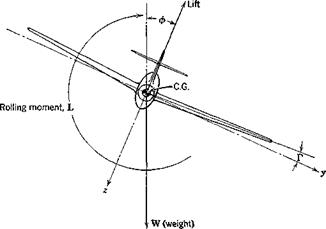ROLL STIFFNESS
 |
Consider a vehicle constrained, as on bearings in a wind tunnel, to one degree of freedom-rolling about the * axis. The forces and moments resulting from a fixed displacement ф are fundamentally different in character from those associated with the rotations a and /? about the other two axes. In the first place if the x axis coincides with the velocity vector V, no aerodynamic change whatsoever follows from the fixed rotation ф (see Fig. 8.4). The aerodynamic field remains symmetrical with respect to the plane of symmetry, the resultant aerodynamic force remains in that plane, and no changes occur in any of the aerodynamic coefficients. Thus the roll stiffness Сц is zero in that case.
If the x axis does not coincide with V, then a second-order roll stiffness results through the medium of the derivative Ct . Let the angle of attack of the x axis be v. x (Fig. 4.4), then the velocity vector when ф = 0 is
![]() V cos a. x 0
V cos a. x 0
_F sin v. x_
After rolling through angle ф about Ox, the velocity vector is (cf. Sec. 4.5)
" V cos otx
V2 = L1(^)Y1 = V sin ctx sin ф (8.3,2)
V sin kx cos ф_
Thus the sideslip component is v = V sin ax sin ф, and the sideslip angle is (4.3.3)
![]() ft — sin 1 — = sin 1 (sin a„ sin ф)
ft — sin 1 — = sin 1 (sin a„ sin ф)
|
As a result of this positive /3, and the usually negative there is a restoring rolling moment Gl^§ i. e.
Thus there is a roll stiffness that resists rolling if ax is >0, and would tend to keep the wings level. If rolling occurs about a wind axis, the stiffness is zero and the vehicle has no preferred roll angle. If a*<0, then the stiffness |
is negative and the vehicle would roll to the position ф = 180°, at which point C = 0 and (7j < 0.
The above discussion applies to a vehicle constrained, as stated, to one degree of freedom. It should not be thought that the derivative С1ф so deduced should be introduced into the rolling moment equation (5.13,176)! The rolling moment we have discussed above arises solely from the aerodynamic effect of fj, and as such is already included in the term of the equation. The usefulness of the above point of view is that it helps one to understand the behavior of free motions that consist principally of rolling about an axis in the plane of symmetry.
Having shown above that airplanes have no first-order aerodynamic roll stiffness, it is worthwhile to digress at this point to show why they nevertheless have an inherent tendency to fly with wings level. They do so because of a secondary effect, involving gravity and Gt. When rolled to an angle ф, there is a weight component mg sin ф in the у direction (Fig. 8.4). This induces a sideslip velocity to the right, with consequent /3 > 0, and a rolling moment that tends to bring the wings level. The rolling and yawing motions that result from such an initial condition are however strongly coupled, so no significant conclusions can be drawn about the behavior except by a dynamic analysis (see Chapter 9).











